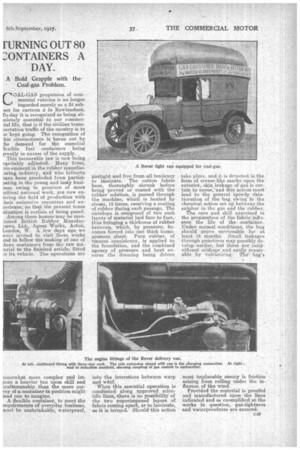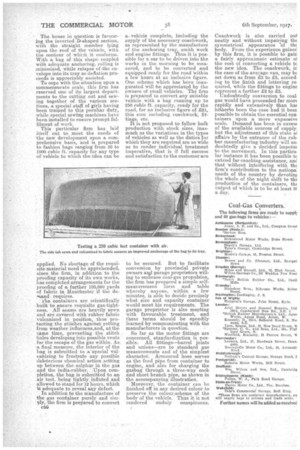FURNING OUT 80 CONTAINERS A DAY.
Page 15

Page 16

If you've noticed an error in this article please click here to report it so we can fix it.
A Bold Grapple with the Coal-gas Problem.
COAL-GAS propulsion of commercial vehicles is no longer kegarded merely as a fit subect for cartoon a In Rowlandson. ro-day it is recognized as being abmlutely essential to our commer!ial life, that is if the civilian-transportation traffic of the country is to le kept going. The recognition of ;hie circumstance is borne out by ;he demand for the essential lexible fuel containers being greatly in excess of the supply.
This inexorable law is now being squitably adjusted. Many firms, pre-eminent in the rubber maritifaO;uring industry, and who hitherto lave been precluded from participating in the young and lusty busiaess owing to pressure of more -.1ritical national work, are now enbering the field of production with :heir extensive resources and experience; so that the present tense situation is Certain of being eased. Among these houses may be men;ioned British Rubber. Manufacmres, Ltd:, Agnes Works, Acton, London, W. A few days ago. we were invited to visit these works and ter follow the making of one of :hese containers from .tbe raw material to the finished article, fitted -io its vehicle. The operations are somewhat more complex and impose a heavier tax upon skill and 3raftsmanship than the mere survey of a container in position might Lead one to imagine.
A flexible container, to meet the requirements of everyday business, must be unshrinkable, waterproof,
gastight and free from all tendency to laminate. The cotton fabric base, thoroughly shrunk before being proved or coated with the rubber solution, is passed through the machine, which is heated by steam, 12 times, receiving a coating of rubber during each passage. The envelope is composed of two such layers of material laid face -to face, thus bringing a thickness of rubber between, which, by pressure, becomes forced into one thick homogeneous sheet. Pure rubber, of viscous consistency, is applied to the foundation, and the combined agency of pressure and heat ensures the dressing being driven
into the interstices between warp and woof.
When this essential operation is conducted along approved scientific lines, there is n.o possibility of the two superimposed layers of fabric coming apart, or to laminate, as it is term,ed. Should this actioa take place, and it is detected in the form of crease-like marks upon the exterior, skin leakage of gas is certain to ensue,' and this action mast lead to the general speedy dete. rioration of the bag owing to the chemical action set up between the sulphur in the gas and the rubber.
The care and skill exercised in the preparation of the fabric influence the life of the container. Under normal conditions, the bag should prove serviceable for at least 18 months. Small leakages through punctures may possibly develop •earlier, but these are insignificant Mishaps and easily repairable by vulcanizing. Thebag's
most implacable enemy is friction arising from Tolling under the influence of the wind.
Provided the material is proofed and manufactured upon the lines indicated and as exemplified at the works in question, gas-tightness and waterproofness are assured.
The house in question is favouring the inverted ,D.shaped section, with the straight member lying upon the roof of the vehicle, with the contour of whi2.11 it conforms. With a bag of this shape coupled with adequate anchoring, rolling is Minimized, while relapse cif -the envelope into its tray as deflation proceeds is appreciably assisted.
To cope with the situation upon a commensurate scale, this firm has reserved one of its largest departments to the Cutting out and sewing together of the various sections, a Special staff of girls having been trained to this peculiar duty, while special sewing machines have been installed to ensure prompt fulfilment of work.
This Particular firm has laid itself out to meet the needs of the new development upon a comprehensive basis, and is prepared to fashion bags ranging from 50 to 1000 cubic ft capacity for any type of vehicle to which the idea can be applied. No shortage of th,e requisite material need be apprehended, since the firm, in addition to the proofing capacity of its own works, has completed arrangements for the proofing of a further 100,000 yards of fabric in Manchester if the de and requires.
rise containers are scientifically built to ensure requisite gas-tightness. All seams are heavily sewn and are covered with rubber fabric vulcanized in position, thus protecting the stitches against rotting from weather influences,ancl, at the same time, preventing the stitch holes developing into possible vents for the escape of the gas within. As a final measure, the interior of the bag is submitted to a "special vulcanizing to frustrate any possible deleterious .chemical action „setting up between the sulphur in the gas and the india-rubber. ;Upon completion, the bag is submitted toan _ air test, being tightly inflated and allowed to ,stand for 12 hours. which
• is adequate to reveal any defect.
In addition to the Manufacture of the gas container purely, and sins%sly, the firm is prepared to convert 050
a. vehicle complete, including the supply of the necessary coachwork, as represented by the manufacture of the anchoring tray, smith work and engine fittings. Thus it is possible for a ear to be driven into the works in the morning to be measured, and to be converted and equipped ready for the road 'within a few hours at an inclusive figure. One scheme which has been inaugurated will be appreciated by the owners of small vehicles. The firm is prepared to convert any suitable vehicle with a bag running up to 25a cubic ft. capacity, ready for the road, for an inclusive figure of-221, this sum including coachWork, fittings, etc.
it is not proposed to follow bulk production with stock sizes, inasmuch as the variations in the types of vehicles as well as the duties for which they are required are so wide as to render individual treatment imperative, that is if full success and satisfaction to the customer are to be 'secured. But to facilitate conversion by provineial private owners a4 garage proprietors willing to embrace coal-gas propulsion, the firm has prepared a simple selfmeasurement form and table whereby anyone, within a few minutes, is able to decide precisely what size and. capacity container would meet his requirements. The garage proprietor is also meeting with favourable treatment, and these terms should be speedily learned by communicating with the manufacturers in question.
So far as the motor fittings are concerned, standardization is possible. All fittings—barrel joints and unions—are to standard gas measurements and of the simplest character. Armoured hose serves as the feed pipe from container to engine5 and also for charging the gasbag through a three-way cock and short branch pipe, as shown in the accompanying illustration.
Moreover. -the container can be finished off in any desired colour to preserve the colour:scheme of the body of the vehicle. Thus it is not rendered unduly conspicuous.
Coachwork is also carried Qui neatly and without impairing the symmetrical appearance of the body. From the experience gained by this firm, it is possible to gain a fairly approximate estimate oi the cost of converting a vehicle tc the new idea. The coachwork, is the case of the average van, may be set down as from -E3 to £5, accord lug to the finish and lettering re. quired, while the fittings to engine represent a further £2 to £3.
• Undoubtedly conversion to coal gas would have proceeded far more rapidly and extensively than has hitherto been the case had it beer possible to obtain the essential Containers upon a more expansive scale. Demand has been in execs: of the available sources of supply. but the adjustment of this state oi affairs by the entrance of the rubber manufacturing industry will undouhtedly give a decided impetsu to the movement, in this particular instance it has been possible 'lx extend far-reaching assistance, and that without interferinswith the firm's contribution to tie nationa: needs of the country by devotins the whole of the night shift to -the production of the -containers, the output of which is to be at least s{ a day.
























